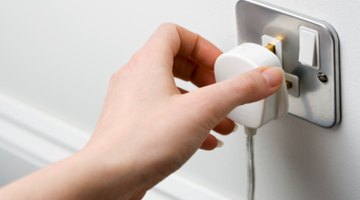How to Test a 220-Volt Outlet
Many homes now contain 220-volt electrical outlets for use with large appliances such as dryers, ovens and window unit air conditioners. These 220-volt circuits are made to handle the larger electrical load that such appliances require when in operation.

Properly testing a 220-volt outlet is a straightforward procedure. With the use of an electrical multimeter, you can tell if your 220-volt circuit is in proper working order.
Things You Will Need
- Digital multimeter
- Screwdriver
Tip
If you find a problem in your circuit, it is best to consult a professional.
Warning
Always use extreme caution when working around live electricity.
-
Turn off the circuit breaker that supplies power to the 220-volt outlet. This reduces the chance of shorting out the circuit when accessing the outlet wires.
-
Remove the cover from the 220-volt outlet receptacle. Use a screwdriver to remove any screws that secure the cover in place. The actual receptacle plug is now in view.
-
Remove the receptacle plug from the box. Remove the two small screws holding the receptacle in place. The receptacle is now free to be taken out of the mounting box.
-
Turn the receptacle around so that you can easily see where the wires connect. There are four wires connecting to four screws marked with the designations "X," "Y," "White" and "GND". The "X" and "Y" screws are connected to either the red or the black wire. The "White" screw is connected to a white neutral wire. The "GND" screw is connected to the ground wire, which will be green or bare.
-
Turn the digital multimeter selector to "AC Voltage." This allows testing for the 220-volt circuit.
-
Turn the circuit breaker back on to restore power in the 220-volt outlet.
-
Touch the multimeter probes to the "X" and "Y" screws of the receptacle. The digital readout of the meter should read 220 volts. If not, this indicates that you have an open circuit conductor or a bad circuit breaker.
-
Touch one probe to the "X" screw and one to the "GND" screw. You should receive a reading of 120 volts. Likewise you should receive a reading of 120 volts between the "Y" screw and the "GND" screw. If one or both of these indicate a zero voltage reading, this indicates that you have an open ground conductor.
The Drip Cap
- Many homes now contain 220-volt electrical outlets for use with large appliances such as dryers, ovens and window unit air conditioners.
- These 220-volt circuits are made to handle the larger electrical load that such appliances require when in operation.
- Properly testing a 220-volt outlet is a straightforward procedure.
- Remove the two small screws holding the receptacle in place.
- The "X" and "Y" screws are connected to either the red or the black wire.
- The digital readout of the meter should read 220 volts.
References
Resources
Writer Bio
Located in southeastern Kentucky, Charles Judd began writing semi-professionally in early 2005 for local publications. His work has been published in his hometown newspapers, the "Jackson Sun" and the "Jackson Times." He has many diverse interests and enjoys writing about various subjects. Charles holds a Bachelor of Science in industrial machine technology.
Photo Credits
- Jupiterimages/Polka Dot/Getty Images
- Jupiterimages/Polka Dot/Getty Images
More Articles



